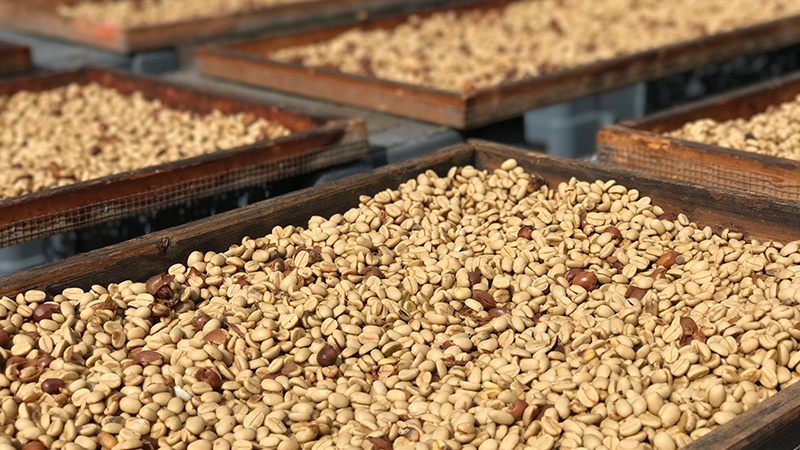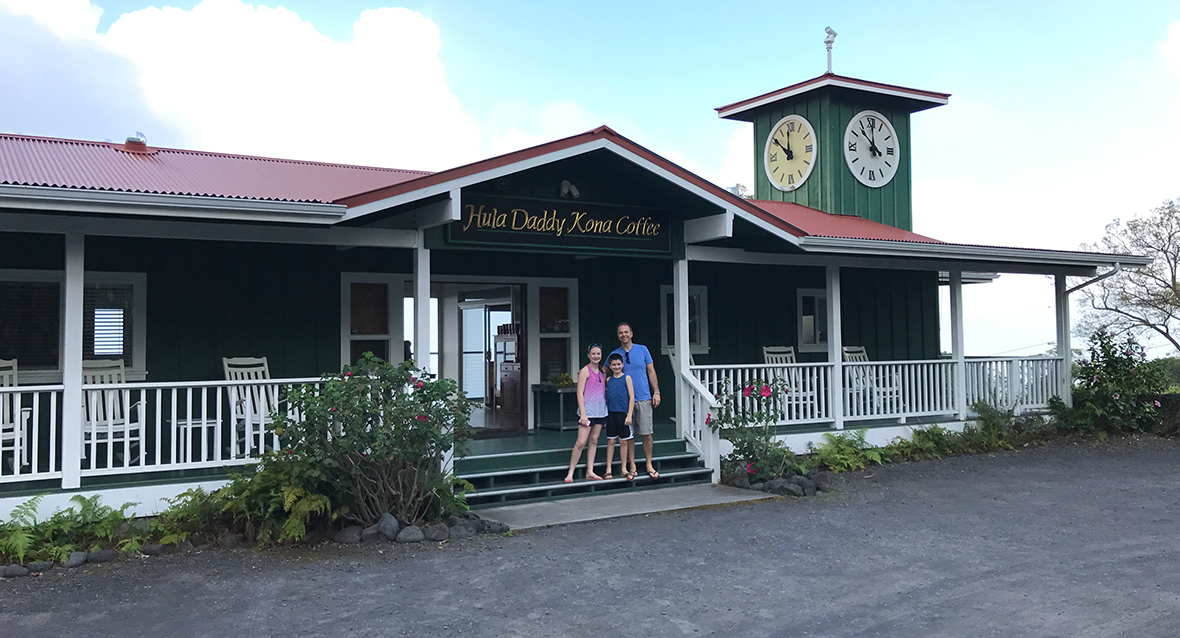
When we were booking our Hawaiian vacation, we were planning on going back to Maui, but when airfare was almost $400 cheaper per person to fly to Big Island, we changed our plans. Plus, the Big Island has two things the other islands don’t: hot lava and coffee farms. The only two things that Brian wanted to do on our vacation was to see hot lava at the Kilauea Volcano and tour a Kona Coffee farm. So we booked the first half of our vacation at the Hilton Waikoloa Village on the northern Kona Coast, and the second half of our vacation at the historic Volcano House in Hawaii Volcanoes National park — right on top of the Kilauea Caldera.
Now, traveling with Brian when he’s excited about something, is a bit crazy. When we visit Disneyland for example, he gets all amped up and excited, rushing us to move faster. It isn’t until he’s in the park and has a few rides under his belt that he can calm down and relax. Knowing this, we decided to make visiting the Big Island Kona Coffee farms our first vacation activity.
Kona sits on the western coast of the Big Island of Hawaii. It is world famous for its coffee belt, the 20-mile stretch of agricultural land with tropical heat that is tempered by afternoon clouds that shade the coffee trees. Kona is the only region in the United States where Kona Coffee is grown and cultivated.
Our first stop was the Hula Daddy Kona Coffee Visitor Center and Tasting Room, an eco-friendly coffee farm, offering plantation and roasting-room tours, as well as Kona Coffee sampling in a tasting room. We arrived right when they opened and only two other people were visiting at the same time, so it was almost like we had a private tour! We were greeted with warm, friendly smiles, were invited to sample the Hula Daddy Kona Coffee and tea, and then we gathered along the veranda looking out at the coffee trees.
Our tour guide Sara began with an overview of the coffee farm’s history and answered some questions about how the coffee is planted in the ground covered in thick lava rock. She then took us down into the plantation to see the trees, the blossoms (called Kona Snow), and the coffee berries up close. We learned about how the trees are cared for, the harvest cycle and harvest process, the different stages of the coffee berries, and even about some of the hazards coffee farmers face, like the wild pigs digging up and damaging the trees.
We then walked over to the trays of coffee berries drying in the sun and learned about their natural coffee bean drying and sorting processes. Our last stop was the roasting room, where we learned about the coffee roasting equipment and process, the different roasts, temperatures, colors, and caffeine levels.
We had a blast visiting the Hula Daddy Kona Coffee plantation. Their boutique operation, focusing on high quality and personal interactions, reminded all of us of the local Manadarin orange farmers from Placer County. For many years, my in-laws ran a small organic Manadarin orchard, and this farm reminded me of their farm. Sara was was really knowledgeable and answered every question. She provided a ton of information, but in a way the kids also understood and stayed engaged, without getting bored.

About Hula Daddy Kona Coffee
In 2002, Le and Karen Paterson bought an 11 acre cow pasture in Kona to see if they could start a coffee farm and create one of the ten best coffees in the world. They hired a local agronomist with expertise in Kona Coffee plantations and planted 7,000 coffee trees. Three years later their first crop produced okay coffee, and each year after that, it just kept getting better and better and they began to win awards.
In 2008, they hired a coffee expert from Minnesota and a soil consultant from Napa Valley, overhauled their process from farm to cup, tripled the cost of production, and saw a drastic increase in quality. In late 2008, their Kona Sweet Coffee was reviewed as one of the top six coffees in the world. That same year, they invested in 20 more acres on the slope of the Hualalai Volcano and carefully selected only the best seeds.
In 2014 they were the top coffee in the Kona Cultural Festival Cupping Competition, and in 2015, they were the top Kona Coffee and the top Hawaiian Coffee in the Hawaii Coffee Cupping Competition.
An Eco-Friendly Coffee Plantation
Hula Daddy Kona Coffee has reduced their carbon footprint by planting more than 31 acres of pasture land with over 17,000 trees. They collect green waste from local restaurants, mix it with wood chips and coffee pulp, and make their own compost — in some years more than 50 tons of compost! They also choose to save energy by drying all of their coffee beans in the sun.
Because of Hula Daddy’s eco-friendly environment, thousands of birds visit the plantation, including hawks, owls, turkeys, pheasant, francolins, cardinals, finches, and doves.
Know Before You Go
- Hula Daddy Kona Coffee Visitor Center and Tasting Room is located at 74-4944 Mamalahoa Highway, Holualoa, Hawaii 96725.
- They are open Monday though Friday (except for major holidays) from 10:00 am to 4:00 pm.
- Enjoy free coffee tasting and tea tasting, as well as free tours of the orchard and roasting room. Tours are not on a set schedule, and instead are offered as visitors arrive.
- Tours are available in Japanese, Korean, and Mandarin by appointment only. Call 808-327-9744.
- Don’t be afraid to ask questions! Their staff is very knowledgeable and are happy to answer any of your questions about the coffee making process.















